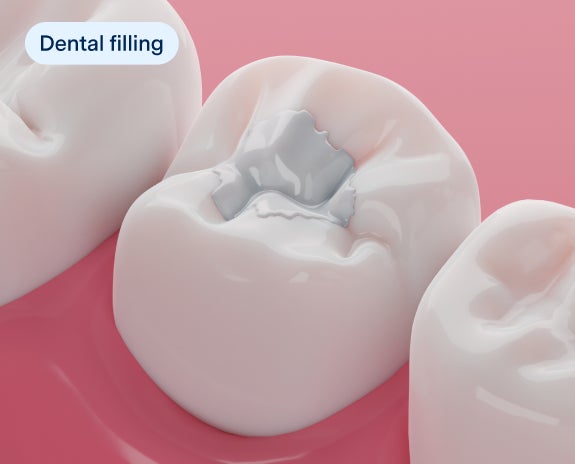Last updated 10.03.2024
Tooth root canal vs tooth filling
Root canal vs. tooth filling: Learn the key differences, when each is needed, and how to choose the right treatment.

Understanding root canals
Root canals are performed when tooth decay has progressed to a severe level, causing infection to spread to the pulp of the tooth. This complex procedure requires a high level of expertise to save the tooth and prevent further infection.

What is a root canal?
A root canal is a dental procedure that treats an infected or inflamed pulp inside the tooth. This treatment involves removing the infected pulp, cleaning the root canals, and sealing the tooth to prevent future infections. Ultimately, the goal of a root canal is to save the tooth.
Learn more about root canals >
Root canal procedure
The root canal procedure involves several steps to ensure the tooth is properly treated and protected:

Examination and X-rays
The endodontist or referred general dentist examines the tooth and takes X-rays to assess the extent of the infection.
Local anesthesia
The area around the affected tooth is numbed to ensure patient comfort.
Dental dam
A small protective sheet is placed around the tooth to keep it clean and free of saliva during the procedure.
Opening and cleaning
An opening is made in the crown of the tooth to access the pulp chamber. Small instruments are used to remove the infected pulp and shape the canals within each root.
Tooth filling and sealing
The cleaned root canals are filled with a biocompatible material, usually gutta-percha, and sealed with adhesive cement.
Temporary filling
A temporary filling is placed to close the opening until a permanent restoration can be placed.
Understanding fillings
Dental fillings are a common and effective treatment for cavities. They help restore the function and integrity of teeth affected by decay. During the procedure, your dentist removes the decayed portion of the tooth and fills the area with a durable material. This not only repairs the damage but also helps prevent further decay.
Learn more about dental fillings >

What are tooth fillings?
Dental fillings are used to repair minor tooth damage, such as small cavities and minor decay. The process involves removing the decayed portion of the tooth and filling it with a material like composite resin, amalgam, gold, or porcelain.
Dental filling procedure
The process of applying dental fillings is straightforward and involves the following steps:

Local anesthesia
The area around the affected tooth is numbed to ensure patient comfort.
Removal of decay
The decayed portion of the tooth is removed.
Cleaning
The area is cleaned to remove any debris or bacteria.
Filling
The prepared cavity is filled with the chosen filling material.
Shaping and polishing
The filling is shaped and polished to match the natural contour of the tooth.

How to know whether you need a root canal vs. tooth filling?
It's important to know when to get either a root canal or a filling to avoid complications in the future. See your dentist for an exam if you experience these signs:
Signs you need a root canal
Extreme sensitivity to hot or cold temperatures
Moderate to severe tooth pain
Swollen or tender gums
Discoloration of the tooth
Signs you need a deep cavity filling
Toothache or mild pain when chewing
Sensitivity to sweet, hot, or cold foods and drinks
Visible holes or dark spots on the teeth
Root canal vs. tooth filling: factors to consider
Your dentist ultimately will decide which procedure is right for you based on your oral health condition, however here are some factors to consider about each:

Treatment time
Root canals typically require one or two appointments, while fillings can often be completed in a single visit.
Recovery time
Fillings generally have a shorter recovery time compared to root canals, which may involve some post-treatment discomfort.
Cost
Root canals may be more expensive than fillings due to the complexity of the procedure and the need for a permanent restoration.
Learn more about root canal cost >
Learn more about dental fillings cost >
Painfulness
Root canals are performed under local anesthesia to minimize discomfort. Fillings also involve local anesthesia, but the procedure is typically less invasive and less painful.

What is the right option?
It's essential to evaluate your current dental situation and consult with a dental professional to make the best decision for your oral health. Your dentist will educate you on the right solution for your condition.
Root canal vs. tooth filling FAQ
Can you get a tooth filling before a root canal?
Yes, a filling can sometimes be placed before a root canal if the decay is not too severe and the tooth's pulp is not yet infected. However, if the decay reaches the pulp and causes an infection, a root canal will be necessary to remove the infected tissue and save the tooth.
In some cases, a temporary filling may be placed before the root canal to protect the tooth until the procedure can be completed. It's essential to follow your dentist's advice to ensure the best outcome for your oral health.
Can I get a tooth filling instead of a root canal?
While it's natural to wonder if a filling could be an alternative to a root canal, the two procedures serve different purposes. A filling is used to repair a tooth with minor decay or damage, but if the tooth's pulp (the inner part of the tooth containing nerves and blood vessels) is infected or severely damaged, a root canal is necessary to remove the infection and save the tooth.
If you avoid a root canal when it's needed, the infection can spread, potentially leading to more severe complications or even the loss of the tooth. It's important to consult with your dentist to determine the best treatment for your specific situation.



